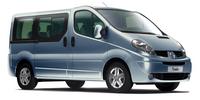Renault's New Trafic Passenger and New Trafic Generation
For A More Mobile World Of Motoring
PARIS - June 5, 2006: At the time of its launch at end-2001, Renault Trafic stood out as a market benchmark. Today, New Trafic Passenger and New Trafic Generation go even further by offering a host of comfort and safety features more commonly associated with the world of passenger cars.
The switch to Euro 4 compliance has resulted in a comprehensive renewal of the range of diesel engines, with the arrival of Renault’s new 2.0 dCi developed in association with Nissan under the Alliance. This powerplant comes in a choice of two versions – 90hp (66kW) and 115hp (84kW) – and offers extra performance, flexibility and fuel efficiency. Meanwhile, the power output of the 2.5 dCi diesel engine – now equipped with a particulate filter – has been increased from 135hp to 150hp (107kW).
The range of six-speed manual and robotized transmissions has also evolved, with the maximum torque capacity uprated from 320Nm to 350Nm.
 |
New Trafic Passenger Authentique and Expression are available in one of two lengths (4.78m or 5.18m), while New Trafic Passenger Privilège comes in a single length (4.78m). Both the Authentique and Expression versions can seat up to nine occupants (eight in the case of New Trafic Passenger Privilège) and replace the former bus and combi versions. They are targeted at business customers, but will also appeal to large families looking for MPV-style vehicles.
New Trafic Generation’s highly flexible interior features a rear benchseat that readily converts into a bed,
 |
New Trafic Passenger is built in Luton (GM, United Kingdom) and Barcelona (Nissan, Spain). New Trafic Generation’s chassis is produced solely in Barcelona alongside that of New Trafic Passenger, while its cabin is manufactured in association with the French coachbuilder Gruau in bespoke premises located close to the factory and dedicated to this upperrange vehicle.



